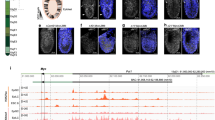Abstract
The Zinc Finger Homeodomain Enhancer-binding Protein (Zfhep) is involved in skeletal patterning, immune cell, muscle, and brain development, and is necessary for life. Zfhep contains a single central homeodomain (HD) adjacent to an isolated zinc finger, the function of which is unknown. The placement of a zinc finger so close to a homeodomain is novel in nature. The aim of this work was to characterize the Zfhep homeodomain (HD) or the zinc finger homeodomain (ZHD), with respect to DNA-binding and protein-protein interactions. Glutathione-S-transferase (GST) fusion proteins containing either just the HD or both the zinc finger and HD (ZHD) were expressed in E. coli. The GST fusion protein affinity-binding assay demonstrated that Zfhep ZHD interacts specifically with the POU domain of the Oct-1 transcription factor. The adjacent zinc finger is required since Zfhep HD alone does not interact with Oct-1 POU domain. Furthermore, ZHD does not bind to the POU homeodomain lacking the POU specific region. These results demonstrate that the Zfhep zinc finger homeodomain motif functions as a protein-binding domain in vitro, and suggests that Zfhep may modulate the activity of POU domain transcription factors. However, neither the Zfhep ZHD nor the HD bound DNA in EMSA or selected a DNA-binding site from a pool of random oligonucleotides. This is the first demonstration of a function for the HD region of Zfhep, which is the first case of a bi-partite domain requiring both a zinc finger and a HD for binding to protein.
Similar content being viewed by others
References
Takagi T, Moribe H, Kondoh H & Higashi Y (1998) Development 125: 21–31
Higashi Y, Moribe H, Takagi T, Sekido R, Kawakami K, Kikutani H & Kondoh H (1997) Journal of Experimental Medicine 185: 1467–1479
Postigo AA & Dean DC (1997) EMBO Journal 16: 3935–3943
Yen G, Croci A, Dowling A, Zhang S, Zoeller RT & Darling DS (2001) Brain Res Mol Brain Res 96: 59–67
Cabanillas AM & Darling DS (1996) DNA & Cell Biology 15: 643–651
Genetta T, Ruezinsky D & Kadesch T (1994) Molecular & Cellular Biology 14: 6153–6163
Darling DS, Gaur NK & Zhu B (1998) Molecular & Cellular Endocrinology 139: 25–35
Funahashi J, Sekido R, Murai K, Kamachi Y & Kondoh H (1993) Development 119: 433–446
Williams TM, Moolten D, Burlein J, Romano J, Bhaerman R, Godillot A, Mellon M, Rauscher III FJ & Kant JA (1991) Science 254: 1791–1794
Watanabe Y, Kawakami K, Hirayama Y & Nagano K (1993) Journal of Biochemistry 114: 849–855
Hovde S, Abate-Shen C & Geiger J (2001) Biochemistry 40: 12013–12021
Wilson DS, Sheng G, Jun S & Desplan C (1996) PNAS 93: 6886–6891
Pabo CO, Peisach E & Grant RA (2001) Annu. Rev. Biochem. 70: 313–340
Matthews JM, Kowalski K, Liew CK, Sharpe BK, Fox AH, Crossley M & Mackay JP (2000) Eur. J. Biochem. 267: 1030–1038
Dai Y-S, Cserjesi P, Markham BE & Molkentin JD (2002) J. Biol. Chem. 277: 24390–24398
Pomerantz J, Sharp P & Pabo C (1995) Science 267: 93–96
Andersen B & Rosenfeld MG (2001) Endocr Rev 22: 2–35
Verrijzer CP, van Oosterhout JA & van der Vliet PC (1992) Mol. Cell. Biol. 12: 542–551
Chen F, Kook H, Milewski R, Gitler AD, Lu MM, Li J, Nazarian R, Schnepp R, Jen K, Biben C, Runke G, Mackay JP, Novotny J, Schwartz RJ, Harvey RP, Mullins MC & Epstein JA (2002) Cell 110: 713–723
Sive H & Roeder R (1986) 83: 6382–6386
Yasuda H, Mizuno A, Tamaoki T & Morinaga T (1994) Mol. Cell. Biol. 14: 1395–1401
Pollock R. (1996) in Current Protocols in Molecular Biology (Ausubel FM, Brent R, Kingston RE, Moore DD, Seidman JG, Smith JA & Struhl K, eds.), pp. Chapter 12, John Wiley and Sons, Inc., New York
Swaffield JC & Johnston SA. (1996) in Current Protocols in Molecular Biology (Ausubel FM, Brent R, Kingston RE, Moore DD, Seidman JG, Smith JA & Struhl K, eds.), pp. Chapter 20, John Wiley and Sons, Inc., New York
Sakata N, Hemmi K, Kawaguchi M, Miura Y, Noguchi S, Ma D, Sasahara M, Kato T, Hori M & Tamaoki T (2000) Biochem Biophys Res Commun 273: 686–693
Kawaguchi M, Miura Y, Ido A, Morinaga T, Sakata N, Oya T, Hashimoto-Tamaoki T, Sasahara M, Koizumi F & Tamaoki T (2001) Biochim Biophys Acta 1550: 164–174
Gonzalez MI & Robins DM (2001) J. Biol. Chem. 276: 6420–6428
Kakizawa T, Miyamoto T, Ichikawa K, Kaneko A, Suzuki S, Hara M, Nagasawa T, Takeda T, Mori J-i, Kumagai M & Hashizume K (1999) J. Biol. Chem. 274: 19103–19108
Yasui DH, Genetta T, Kadesch T, Williams TM, Swain SL, Tsui LV & Huber BT (1998) Journal of Immunology 160: 4433–4440




